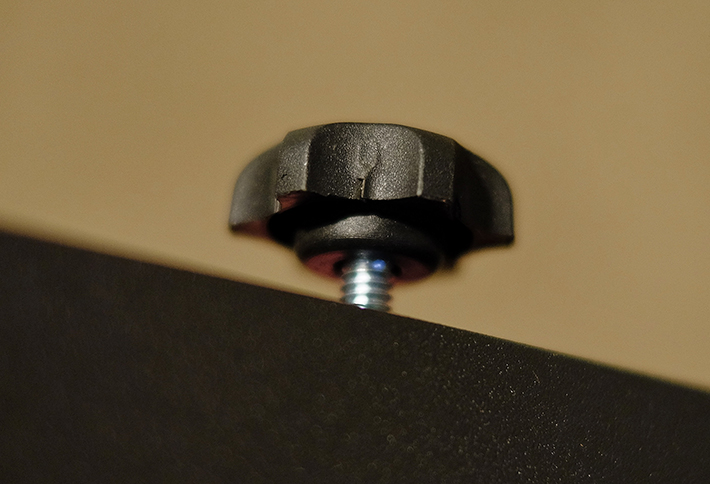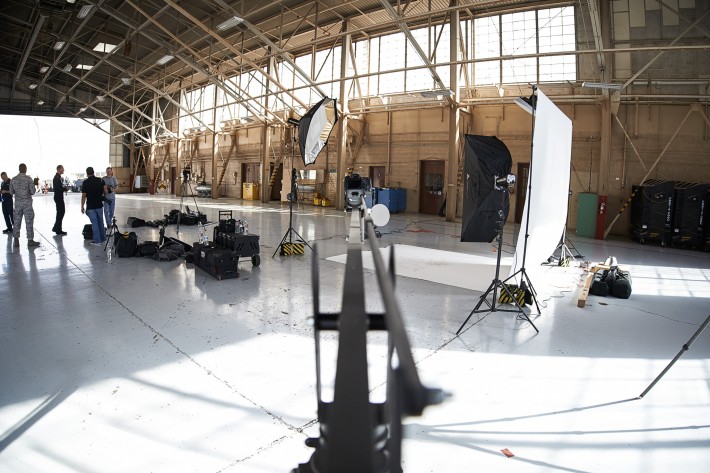Camera cranes and jibs are becoming more commonplace in the DSLR video maker's arsenal due to more, light weight options and falling prices. ProAm calls their Orion DVC210 the "first camera crane built specifically for DSLR cameras" and it extends to eight feet tall for a surprisingly affordable $300. Sounds great on paper, but how does it function in practice?
Cranes and jibs, like tripods, have a short list of things that make them either excellent or "meh" at their jobs. They have to be smooth, they have to operate easily, if we're talking DSLRS they should be pretty light weight, and they should be well constructed so I don't fear for my camera's life as I lift it into the air. So let's break down the Orion in each of those categories starting with the all-important build quality.
I was pretty impressed with how sturdy the Orion is. It breaks down into two major parts which slide and screw into each other. I appreciated how large of a lip ProAm built into the connection area of the pieces. It makes me feel like the two pieces won't break apart even under a lot of stress, or if for some reason I went over the recommended weight limit of 10 pounds. Everything fits together well and feels strong. See below for the two major pieces next to a tripod.

So the takeaway is that the build quality here felt great, all except for one thing: the connection joints and the handle that allows for independent tilt control over the camera plate are held in place only by what are, in my opinion, the cheapest possible little screw pieces. They are standard screw bolts with really cheap plastic twist tops. Within the first few minutes of use, I already noticed a hairline crack on one of the screw handles.

With the rest of the crane feeling of really nice quality, I was pretty disappointed with these pieces. They are pivotal to the strength of the whole crane, but the build quality feels like an afterthought. These pieces contain the only plastic parts found on the whole crane, and I get the sense that plastic could have been easily entirely avoided.


Let's talk weight: I like how beefy the crane is without being heavy. It's surprisingly light weight. Not as light as if it were made of carbon fiber, but the aluminum isn't too bad at all. I never really felt overly encumbered by the crane, but it's definitely not something you'll want to try and backpack to a location. I stuffed it in the trunk of a Hyundai sedan, assembled it on location, and easily moved it and the Gitzo tripod I attached it to around set by myself. So a thumbs up in this category.
Operating this crane is really, really simple. It tilts and rotates on the center column, where the crane attaches to a tripod and most of the weight will be concentrated. The panning swivel is well constructed with ball bearings, making it pan very smoothly and quickly. It could be improved by instituting a kind of padded braking system that forces it to move at a slower but consistent pace like you find on high-end video heads, but for the price point what the Orion has is more than satisfactory.
When you look down the length of the crane with a camera on the end, you'll be happy to see basically zero bowing. The crane is capable of hoisting its own weight and the weight of a DSLR without issue. It can be a little jittery/wobbly when you try and hold it at the apex of your crane movement, but you can compensate for this with stronger arms or counterweights... and practice. A lot of practice.


Though the base price of this crane is $300, there are a lot of optional add-ons that, frankly, I would say you need. There is an additional panning head attachment that allows you to pan the camera on the crane from the hoisting point, there is a mount for a screen so you can see what you're doing, an additional extension on the length, and most importantly the carry bag. The bare-bones unit doesn't come with a bag, and quite frankly it's pretty necessary unless you have a container prepared for this. I certainly missed having a bag. That can increase the total price to between $400 and $600 depending on what you feel like you must have, but I do believe this is money well spent here. It will make your production with the crane a lot easier and better.

Besides those aforementioned plastic screws that keep the crane together, there really is only one thing about this crane that I don't like: the same type of bad screw is used to hold the manual control over the tilt, and it's in such a manner as to be difficult and time consuming to release. When held in place, the tilt is actually kept at a certain angle through the whole crane motion. However, you can release this and control the tilt manually. This is fantastic, but you can't make this decision while operating the crane. Because of the way the crane is constructed and the way ProAm built the manual-override fastening screw, it takes two hands to unhitch the screw point. This is frustrating when you might want to quickly swap between auto and manual tilt, and forces you to decide very early on which you would prefer for a certain shot. Though this is not a big deal for major set pieces, if you are working a scene on the fly it can be frustrating.
What I liked:
Very light weight
Great height
Easy to control
Smooth panning base and tilting mechanism
Low initial price point
Expandable options
What could use improvement:
High likelihood to get much more expensive than it initially appears
Plastic screw joints are flimsy
Slow-to-use manual/auto switch for tilt
The Orion from ProAm gets a lot right when it comes to a low-cost, entry level crane for a DSLR cinematographer. Though I have to dock them points when it comes to the cheap quality of their screws that live on pivotal places on the crane as well as the difficulty of switching between auto and manual tilt control, overall the modularity/expandability of the unit is a good thing (but also can be seen as a bit of a let down since you can find yourself needing to spend quite a bit more).
You can get the ProAm Orion as well as other ProAm cinema gear at ProAmUSA.com.
NOTE: No, I did not counterbalance this one in the images above because I did not have any due to the constraints of this review, but I do highly recommend it and actually ProAm's warranty does not cover incidents that occur when the crane is not counterbalanced.
Photos of me looking like an idiot on set by the amazing Dan Tabar.







No footage? These things are cool, but if you buy one (and that's so tempting at this price, right?), you're gonna wind up using it all the time, which means the effect is gonna real old, real quick. Cranes shots and similar moving pans work best when they're used sparingly. Just look how cliched slider shots are already. If you get one, easy does it!
It's like eating fatty foods. All in moderation!
And the footage looks like crane footage.
How the hell can you see what your shooting?!?
It's tough, but that's why I recommend a monitor. There is an additional piece you can get with it for that purpose.
I wonder if you can get a wireless monitor?
Do you know of one? Link me. I'd be game to try it out. Other than a CamRanger I mean. That I already know works well.
No, I was just thinking out loud in that statement. I suppose a Google search may turn up stuff, especially from China.
""They are pivotal to the strength of the whole crane, but the build
quality feels like an afterthought. These pieces contain the only
plastic parts found on the whole crane, and I get the sense that plastic
could have been easily entirely avoided.""
A chain is only as strong as it's weakest link!
I have a crane similar to this one distributed by Sevenoak for a hundred bucks less but without the tilt mechanism. It rises and falls level but that's not an issue for me because I paired it with a CamRanger with the remote head. It won't tilt as much but I don't have to worry about plastic parts breaking cos the ones there are aren't crucially located. Panning won't be as fast as a manual system but a slow controlled tilt or pan is better for video anyway. Fast camera movements just give viewers headaches. What I'm not entirely happy with about the CamRanger system is the choppy view as it moves. If you're a stickler for smooth monitoring, I suggest looking elsewhere. But as far as convenience is concerned, anyone with an iOS device and the CamRanger app or CamRanger Share app can connect to my CamRanger's signal and view the same choppy view I'm getting instead of crowding around the single monitor. (The recorded video isn't choppy, just the one sent through the wifi signal. The video recorded in the card is just fine.)
What I am in the market for, though, is a tripod sturdy enough to hold my setup. I noticed you don't use counterweights but I feel more comfortable having them and this is putting a lot of strain on my travel tripod so I was wondering if there are any affordable heavy duty tripods out there you've tested and could recommend. The jib is around 5 kilos (11 pounds) in weight with about 9 to 10 pounds on either end.
p.s. Emphasis on the affordable ;-)